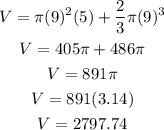Observe the given figure carefully.
It is a composite cylinder with a hemisphere placed at the top.
The radius of the hemisphere is the same as the radius of the cylinder,

The height of the cylindrical part is 5 yards,

Consider the formulae,

Consider that the volume of the composite figure will be the sum of the volume of cylindrical and the volume of the hemispherical part,

Substitute the values,

Thus, the required volume of the given composite figure is 2797.74 cubic yards.